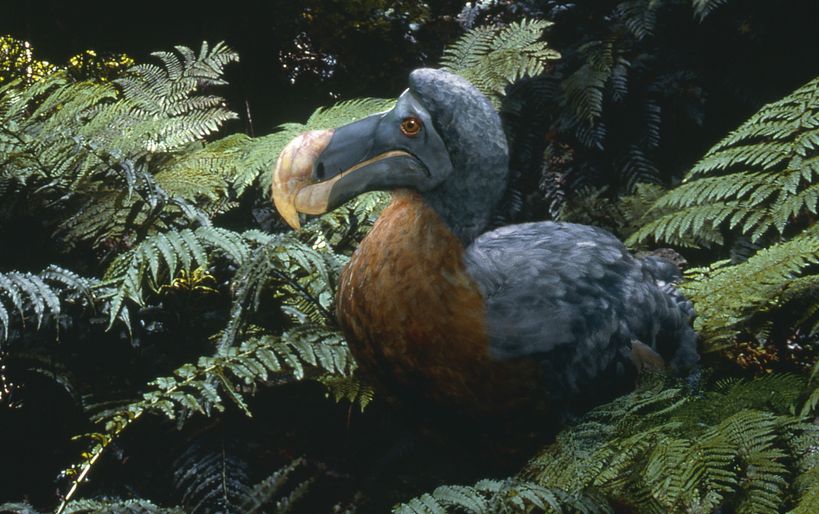Colossal Biosciences plans to de-extinct the dodo, but some scientists question whether it’s ethical—or even plausible
:focal(2250x1500:2251x1501)/https://tf-cmsv2-smithsonianmag-media.s3.amazonaws.com/filer_public/3d/2c/3d2c3395-7a43-4c83-b0c1-9746d8177b83/gettyimages-1189404481.jpg)
The dodo, now extinct, weighed about 50 pounds, had blue and grey feathers and couldn’t fly. David Tipling / Education Images / Universal Images Group via Getty Images
Over the past year and a half, a biotechnology company has made headlines with its ambitious plans to genetically recreate members of two extinct species—the woolly mammoth and the thylacine, or Tasmanian tiger. On Tuesday, the company, called Colossal Biosciences, added a third animal to its de-extinction bucket list: the dodo bird.
“I’ve always been fascinated with the dodo,” Beth Shapiro, the lead paleogeneticist at Colossal, tells Vice’s Becky Ferreira. “It’s the poster child, in a sad way, for how human habitat alteration can drive species to extinction.”
Once, dodos were denizens of the Indian Ocean island of Mauritius, but human explorers and their introduced animals hunted them to extinction by the end of the 17th century. Now, Colossal claims it can bring back the large flightless bird by editing the genomes of its living relatives. In this way, it might engineer an animal that fills an ecological role similar to the dodo’s, per Wired’s Matt Reynolds.
But the scientists are still a long way off from achieving such a breakthrough with the dodo—or even with the mammoth or thylacine. They are still developing the genetic processes needed to do so, writes MIT Technology Review’s Antonio Regalado. In the meantime, other researchers are skeptical that the company can accomplish what it has set out to do.
“De-extinction is a fairytale science,” Jeremy Austin, an evolutionary biologist at the University of Adelaide in Australia, told the Sydney Morning Herald’s Liam Mannix last year. “It’s pretty clear to people like me that thylacine or mammoth de-extinction is more about media attention for the scientists and less about doing serious science.”
To recreate some version of the dodo, the scientists plan to edit genes from the Nicobar pigeon, the dodo’s closest living relative. They have already successfully sequenced the extinct bird’s genome from ancient DNA. Next, they hope to remove germ cells from an egg of a pigeon, edit the genes to make them more dodo-like and implant the cells back into a pigeon egg, Shapiro tells CNN’s Katie Hunt. This technique has worked to breed chickens, but the dodo project is new territory.

“That’s the big, hard part jumping from chicken species, which many labs in the world do, to other bird species,” Mike McGrew, who does avian gene editing at the University of Edinburgh and is on Colossal’s scientific advisory board, says to CNN. “I’ve been trying for about ten years to culture germ cells from other bird species. It’s hard.”
Even if the scientists overcome the technical challenges and create an animal with genes like a dodo, it might not behave like one. The proxy bird will need to figure out how to survive without other members of its species to learn from. “There is nobody around to teach the dodo how to be a dodo,” Mikkel Sinding, a paleogeneticist at the University of Copenhagen, tells Scientific American’s Christine Kenneally.
Then, Colossal would have to contend with where its new creature would live. “It would not really be a dodo—it would be a new species. But it still needs an environment,” Jennifer Li-Pook-Than, a gene-sequencing specialist at Stanford University, tells MIT Technology Review. “What would that mean, ethically, if one is not available?”
Shapiro tells Ars Technica’s John Timmer that invasive species introduced to Mauritius will have to be removed before dodos can survive there again. “And in that way, this project will help to reinvigorate and revive these ecosystems,” she says.
“I think this is an opportunity where, given the man-made nature of the extinction of the dodo, man could not only bring the dodo back, but also fix what was done to parts of the ecosystem to reintroduce them,” Colossal founder Ben Lamm tells Vice. “There’s a lot of benefits from a conservation perspective, in terms of what we can learn from rewilding.”

According to In-Q-Tel, the venture capital arm of the CIA and one of Colossal’s investors, the project could also advance gene-editing technology, which could later promote healthcare or food security. “Strategically, it’s less about the mammoths and more about the capability,” wrote two of the firm’s executives in a blog post last year. Shapiro tells CNN that using gene-editing techniques to move traits between other bird species could make them more resilient to diseases or climate change.
Colossal has raised $225 million since it launched in 2021. But some scientists argue that funding de-extinction attempts is not the best way to support species conservation.
“There’s so many things that desperately need our help. And money,” Julian Hume, an avian paleontologist at London’s Natural History Museum, tells CNN. “Why would you even bother trying to save something long gone, when there’s so many things that are desperate right now?”
SOURCE: https://www.smithsonianmag.com







